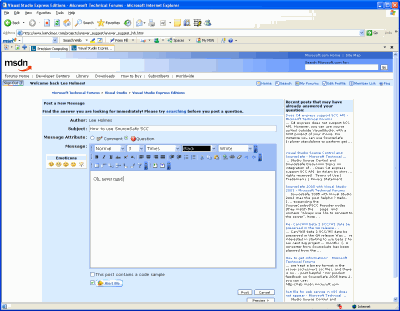Ideas to Cut Off Duplicate Questions in Forums
Josh Ledgard recently wrote an excellent post: Two Ideas to Cut off Duplicate Questions in Online Forums. It deals with a problem that clogs almost every technical community: some users treat the group as their personal support oracle. This happens in online forums, mailing lists, IRC, blogs, and more. Heck, I’d say that 70% of the questions posted to our internal Microsoft mailing lists could have been solved with a few minutes of research. Got an error message? Post something to the group. Computer looking at you funny? Post something to the group. Not sure what to have for lunch? Post something to the group.
The community researchers that answer questions on Google Answers make their money off of exactly this type of ignorance. Although some of the answers require above-average searching abilities, others turn up on the first page of search results.
Hence the exhasperated shouts of RTFM, Just Google It, and others. Those don’t help, though. They show you to be a pompous jerk who likes to belittle others. The solution is to either gracefully help change the user’s habits (so that they do more homework before asking a question,) or seamlessly integrate the research into their habits.
Josh’s idea covers the latter. He suggests that sites (such as the MSDN Forums) integrate a little live search feed to the right of the “Post a Question” form. It’s a great idea.
Now, here’s a little compressed version of the Microsoft product cycle. Being a Program Manager at Microsoft, he was nice enough to even draft a rough mock-up.
Now, being a developer at Microsoft, the next step in a project is to mock up a hack-and-slash technical prototype. At this point, you’re really just trying to prove to yourself (and other technical folks) that the idea is possible. These prototypes also give you a basis from which to make a development time estimate for the feature. I’ve posted it here, although there was really no question that this specific feature is technically possible.
Next, you might want to construct a hi-fidelity prototype to show others. The guts are still hack-and-slash, but the interface is much more functional. Usability tests, and executive demos are a common target for this class of prototypes. I’ve posted it here. HTML is a great prototyping medium for UI, as is Macromedia Flash.
When you understand enough about the feature to know what you want, the ball again sits in the Program Manager’s court for detailed functional specification. From there, it goes to the UI team for detailed colour and layout specification. Finally, it goes to development and testing for the full-fledged implementation.

